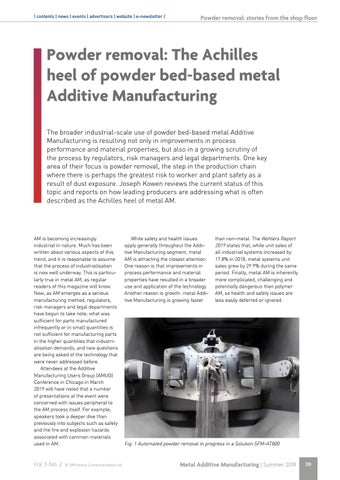| contents | news | events | advertisers | website | e-newsletter |
Powder removal: stories from the shop floor
Powder removal: The Achilles heel of powder bed-based metal Additive Manufacturing The broader industrial-scale use of powder bed-based metal Additive Manufacturing is resulting not only in improvements in process performance and material properties, but also in a growing scrutiny of the process by regulators, risk managers and legal departments. One key area of their focus is powder removal, the step in the production chain where there is perhaps the greatest risk to worker and plant safety as a result of dust exposure. Joseph Kowen reviews the current status of this topic and reports on how leading producers are addressing what is often described as the Achilles heel of metal AM.
AM is becoming increasingly industrial in nature. Much has been written about various aspects of this trend, and it is reasonable to assume that the process of industrialisation is now well underway. This is particularly true in metal AM, as regular readers of this magazine will know. Now, as AM emerges as a serious manufacturing method, regulators, risk managers and legal departments have begun to take note; what was sufficient for parts manufactured infrequently or in small quantities is not sufficient for manufacturing parts in the higher quantities that industrialisation demands, and new questions are being asked of the technology that were never addressed before. Attendees at the Additive Manufacturing Users Group (AMUG) Conference in Chicago in March 2019 will have noted that a number of presentations at the event were concerned with issues peripheral to the AM process itself. For example, speakers took a deeper dive than previously into subjects such as safety and the fire and explosion hazards associated with common materials used in AM.
Vol. 5 No. 2 Š 2019 Inovar Communications Ltd
While safety and health issues apply generally throughout the Additive Manufacturing segment, metal AM is attracting the closest attention. One reason is that improvements in process performance and material properties have resulted in a broader use and application of the technology. Another reason is growth: metal Additive Manufacturing is growing faster
than non-metal. The Wohlers Report 2019 states that, while unit sales of all industrial systems increased by 17.8% in 2018, metal systems unit sales grew by 29.9% during the same period. Finally, metal AM is inherently more complicated, challenging and potentially dangerous than polymer AM, so health and safety issues are less easily deferred or ignored.
Fig. 1 Automated powder removal in progress in a Solukon SFM-AT800
Metal Additive Manufacturing | Summer 2019
119
